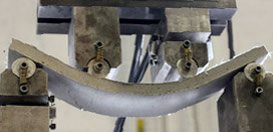Self-Healing Concrete
God Invented It First
What if we could design a material for roads that would only get small cracks that resealed with chemical bonds as good as new?
| Creation: | Human Muscle Tissue |
|---|---|
| Technology: | Self-Healing Concrete |
Engineers are now looking to God’s creation for innovative ideas in architecture. From new ventilation systems that imitate termite mounds to plots of plants on rooftops, building design will never be the same. Even the basic building block, concrete, has been altered based on insights from human muscles.
Three basic types of muscles exist in the human body—smooth, skeletal, and cardiac (heart). Two are of special interest to concrete engineers. Smooth muscles control most involuntary actions, such as digestion. Their fibers are arranged randomly and don’t bulk up. Skeletal muscles allow us to move voluntarily, and these can be strengthened with exercise.
Unlike smooth muscles, skeletal muscles are organized in intricately bound bundles. A skeletal muscle is a bundle of fascicles, and each fascicle is a bundle of fibers. Each fiber contains hundreds of myofibrils, and every myofibril is a bundle of about 4,500 protein filaments. Each of those filaments is a bundle of many long protein polymers.
Because skeletal muscle is a bundle of bundles of bundles, heavy burdens get divided among the many bundles. Sharing the load this way protects against overstressing the muscle. Instead of tearing the entire muscle, excessive loads normally cause only small scattered tears. These tiny tears are called microtrauma. When microtrauma occurs, muscles spend a few days building more protein to replace the torn or damaged protein polymers. Soon the muscle fibers are as strong as ever. Repairing a large tear would be very difficult, but minor injuries are generally small and easily mended.

Photo: Steve Gschmeissner | Photo Researchers, Inc.
This is all well and good, but how does muscle structure specifically apply to concrete?
Ordinary concrete is a mixture of cement, sand, and water. Once it dries, concrete is brittle, so when it gets stressed, it cracks. Cracks typically spread through the concrete and require expensive repairs. By replacing the sand with microfibers, the concrete isn’t brittle—in fact, it can even bend! When the stress on the concrete is excessive, the cement around the microfibers is designed to fracture before the microfibers.
Microfibers divide the concrete into small sections, akin to muscle bundles. This allows heavy loads to be divided and shared. Because the microfibers are arranged randomly, like those in smooth muscle, stress from any direction can be absorbed. And when a small crack does appear, it does not spread beyond its section.
And like muscle, this new concrete repairs itself. Tears in stressed muscles are usually small, allowing intact fibers to act like splints during healing. Likewise, microfibers in selfhealing concrete bridge tiny cracks while the concrete heals itself. The dry cement powder in a small crack mixes with water vapor and carbon dioxide from the air to form limestone. This limestone fills the tiny crack and dries around the microfibers.
The “healed” concrete is as tough and strong as the original. But like smooth muscle, this remodeled concrete does not bulk up. If it did, bridges and buildings made from it would swell!
Self-healing concrete is an amazing invention, based on God’s designs. The possibilities are unlimited for those who expect to find intelligent design throughout the created world!

Bending Without Breaking
Self-healing concrete works because it can bend. When it’s strained, many microcracks form instead of one large crack. Here a force of 5 percent tensile strain does not break the concrete slab. Regular concrete would fail at .01 percent tensile strain.
Photo courtesy of Nicole Casal Moore, University of Michigan
Answers Magazine
January – March 2012
How can we construct safer buildings? How can we clean up emissions from power plants? Increasingly, engineers are turning to God’s original designs in nature to solve difficult engineering problems. What a testimony to our wise and caring Creator! Also, learn how God is using Amish believers in the USA to help build a new full-size Ark. Plus, discover what the Bible says about those mysterious giants, the Nephilim.
Browse IssueRecommended Resources

Answers in Genesis is an apologetics ministry, dedicated to helping Christians defend their faith and proclaim the good news of Jesus Christ.
- Customer Service 800.778.3390
- Available Monday–Friday | 9 AM–5 PM ET
- © 2025 Answers in Genesis





